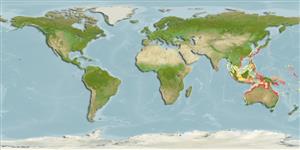>
Callionymiformes (Dragonets) >
Callionymidae (Dragonets)
Etymology: Callionymus: Greek, kallion, comparative of kallos = beautiful + Greek, onyma = name; with a better name .
Environment: milieu / climate zone / depth range / distribution range
Ecologia
marinhas demersal; intervalo de profundidade 5 - 38 m (Ref. 75992). Tropical
Southwest Pacific.
Tamanho / Peso / Idade
Maturity: Lm ? range ? - ? cm
Max length : 14.3 cm TL macho/indeterminado; (Ref. 30504)
Espinhos dorsais (total) : 4; Raios dorsais moles (total) : 9; Raios anais moles: 9. Body brown above, closely speckled with whitish spots, whitish below. First dorsal fin in males light, spines with faint dark spots. In females distally dusky. Second dorsal fin, caudal fin, pectoral and pelvic fins with darker spots. Anal fin with a broad dusky margin. First and second spine of first dorsal fin with filaments of equal length, at least 2 times longer than first ray of second dorsal fin. Third and fourth spines of first dorsal fin not filamentous (Ref 42832).
Life cycle and mating behavior
Maturities | Reprodução | Spawnings | Egg(s) | Fecundities | Larvas
Gloerfelt-Tarp, T. and P.J. Kailola, 1984. Trawled fishes of southern Indonesia and northwestern Australia. Australian Development Assistance Bureau, Australia, Directorate General of Fishes, Indonesia, and German Agency for Technical Cooperation, Federal Republic of Germany. 407 p. (Ref. 5978)
Categoria na Lista Vermelha da IUCN (Ref. 130435)
Ameaça para o homem
Harmless
Utilização humana
Peixe desportivo: sim
Ferramentas
Relatórios especiais
Descarregue XML
Fontes da internet
Estimates based on models
Preferred temperature (Ref.
123201): 24.1 - 28.8, mean 27.6 °C (based on 322 cells).
Phylogenetic diversity index (Ref.
82804): PD
50 = 0.5000 [Uniqueness, from 0.5 = low to 2.0 = high].
Bayesian length-weight: a=0.00912 (0.00408 - 0.02036), b=2.77 (2.59 - 2.95), in cm total length, based on LWR estimates for this Genus-body shape (Ref.
93245).
Nível Trófico (Ref.
69278): 3.3 ±0.4 se; based on size and trophs of closest relatives
Resiliência (Ref.
120179): Elevada, tempo mínimo de duplicação da população menor que 15 meses (Preliminary K or Fecundity.).
Fishing Vulnerability (Ref.
59153): Low vulnerability (10 of 100).
